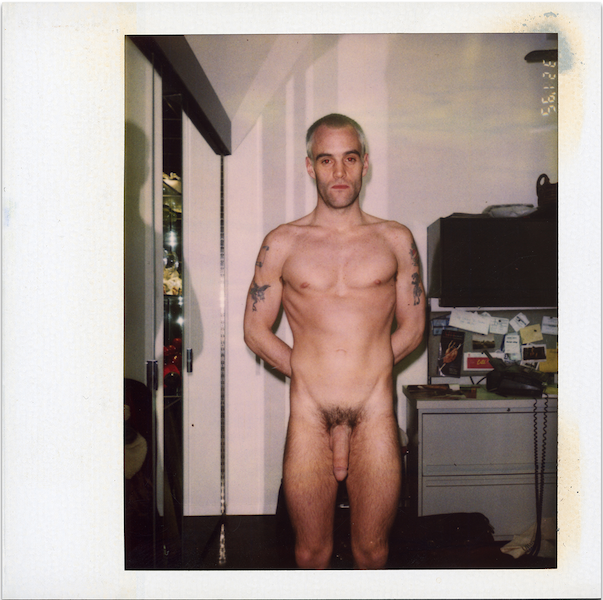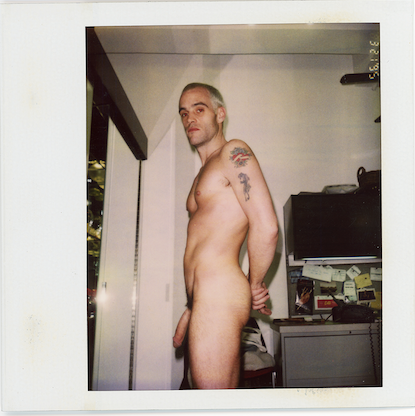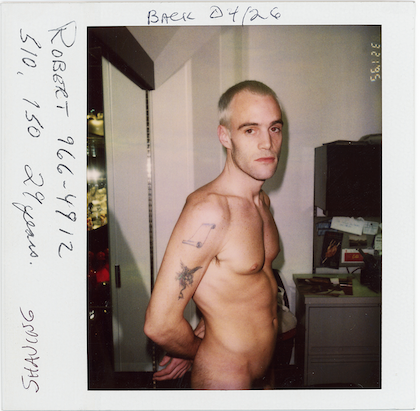SOLD. Authentic Robert Blanchon ‘Casting Call’ Polaroids 1990’s
*** Robert (Blanchon), New York City 1997. Set of Three Original Polaroids / Anonymous Photographer. Initialed by the Photographer on Verso.
Original Polaroids are SOLD.
Polaroid measures exactly 3.108 × 3.024 inches (photo area) and 4.233 x 3.483 inches (total area). That’s 7.894 x 7.6801 cm (photo area) and 10.752 x 8.847 cm (total area).
Part of a series & digital prints available here:
Collection of Casting Call Male Polaroids 1990’s
Artist Statement: Anonymous
“I was photographing male nudes for gay erotic magazines including Advocate Men, Mandate, Torso, & Playgirl in the 1990s. I was always interviewing potential models. I placed ads in the classified section of the local gay weeklies, like HX, NEXT (NYC), and Frontiers (LA). There were many more interviews than magazine-approved photography sets. Even when I knew the model wasn’t a good candidate for the job, I shot them. I never had the heart to reject anyone; I left that up to the editors. Many Polaroids have my handwritten details of the candidate’s name, age, height, weight, and phone number. The backgrounds are of the various apartments I lived in NYC and LA.
Besides the obvious first impression of these guys hard-on, are a selection of men of every size and shape, and from every race and culture you’d find in NYC and LA in the 90s represented. It’s a capsule of an era. I see vulnerability in many of these men, while others present themselves as invincible. You can’t look at them without wondering what the rest of their story was — where their lives took them. And wonder, too: how many are no longer with us?”
– J.P., June 2021
PRESS & RESEARCH:
https://www.e-flux.com/announcements/29934/david-wojnarowicz-robert-blanchon/
https://visualaids.org/projects/robert-blanchon-monograph
https://visualaids.org/artists/robert-blanchon
Revisiting the Provocative AIDS Art of Robert Blanchon
https://www.nytimes.com/1999/10/25/arts/robert-blanchon-34-conceptual-artist.htmlhttp://dlib.nyu.edu/findingaids/html/fales/blanchon/bioghist.html
http://dlib.nyu.edu/findingaids/html/fales/blanchon/
https://newsgrist.typepad.com/visualaids/2010/02/via-the-new-york-timesrobert-blanchontraceybarry-gallery-bobst-librarynew-york-university-70-washington-square-southgreenw.html
From the Archives: Art & AIDS—The Stuff Life Is Made Of
https://www.museoreinasofia.es/en/collection/artwork/robert-blanchon
https://www.the-artists.org/robert-blanchon/
https://www.e-flux.com/announcements/29934/david-wojnarowicz-robert-blanchon/
https://www.sashaarchibald.com/You-Make-Me-Feel-Mighty-Real
Robert Blanchon (1965–99) was an American artist born in Foxboro, Massachusetts. His conceptual artworks often dealt with histories of American Conceptual Art, the politics of AIDS, and representations of queer sexuality. Blanchon attended the School of the Art Institute of Chicago from 1984 to 1989, earning both a BFA and a MFA. While in Chicago, Blanchon was an active participant in the non-profit art scene, curating exhibitions at N.A.M.E. gallery, contributing to Tony Tasset, et al.’s artist project Anonymous Museum, and designing a poster for the City of Chicago’s billboard campaign Art Against AIDS: On the Road.
From 1989 to 1994, Blanchon lived in New York City and worked in the communications department of the New Museum of Contemporary Art while producing his photographic, sculptural, performance, and video artworks. He had a studio on Canal Street where he completed many of his early photographic series, including the stains, tattoos, and greeting cards series. Also during this period, Blanchon created two of his best known and most exhibited artworks, Untitled (self-portrait) (1991), a series of 14 self-portraits commissioned by street artists, and Protection(1992), a letter from the artist to his mother telling her he was HIV-positive, juxtaposed with her 12-page response.
Blanchon had solo exhibitions in New York City at Artists Space in 1994 and at White Columns in 1995. In 1995, he moved to California to take a position as an artist-in-residence at the University of California, Irvine. While in California, he produced the video let’s just kiss + say goodbye (1995), which was exhibited in national and international film festivals, and he had two solo shows, at the Los Angeles Center for Photographic Studies in 1996 and at Marc Foxx Gallery in the following year.
In the spring of 1998, Blanchon moved back to Chicago to become an artist-in-residence at the School of the Art Institute of Chicago, and in the fall of the same year, he took another artist-in-residence position at the University of North Carolina at Chapel Hill. By the end of the summer Blanchon was hospitalized due to complications related to AIDS, and on October 3, 1999, he died at the of age 33.
Developed in close collaboration with the NYU Fales Library, New York, this unique exhibition concentrates on the photography, videos, and films produced by the artists during their practice.


